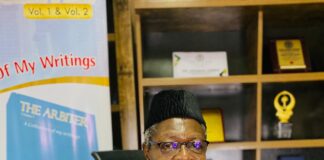The Arbiter
Hijab. This five-letter word has refused to take leave of our public discourse for long. Many female Muslims all over the world love to don the garb because they are fulfilling a part of the injunctions of their religion. But some Christians will have none of it. No one can say why. It may, perhaps, be out of misunderstanding, fear, envy, mischief or a mix of the above.
What is hijab, one may ask, that its love or hate has seen protagonists and antagonists grappling with one another around the world? Hijab, an Arabic word, means a partition, screen, barrier. In Islam, though, it has a wider meaning. It can refer to the “veil” that separates man, world, from God, and isolate women from men in the public sphere, to maintain modesty and privacy from unrelated males.
Physical hijab comprises two parts. First is the khimar – a veil that covers the head (sometimes face, called burqa), neck and bosom. And the other is the jilbab, and it covers the torso, arms and legs. But we are more conversant with the hijab as a veil covering the hair, neck and chest of women. And it is an issue worrisome to those who hate it.
Though the veil (hijab) has a standard in terms of size and texture and goes together with the jilbab (or modest covering), a Muslim girl could wear a mini-skirt or tight-fitting trouser but there would be a problem if she wears a “veil” that covers only the neck, even if it’s meant for fashion.
This played out on December 12 in Nigeria when the Body of Benchers refused a law graduate, Amasa Firdaus Abdulsalam, entrance into the International Conference Centre for call to the bar. She was accused of not been properly dressed because of the hijab she wore, they ruled.
But why do Muslim women insist on wearing the hijab despite discrimination, intimidation, marginalisation and threats? Many verses of the Qur’an instruct Muslims to dress modestly, one of which is Surah 24:31. It tells women to guard their private parts and draw their khimār over their bosom, Muslim women find hijab as the best form of dressing.
“And say to the believing women they should lower their gaze and guard their private parts; that they should not display their beauty and ornaments except what (must ordinarily) appear thereof; that they should draw their khimār over their breasts and not display their beauty except to their husbands, their fathers, their husband’s fathers, their sons, their husbands’ sons, their brothers or their brothers’ sons, or their sisters’ sons, or their women, or the slaves whom their right hands possess, or male servants free of physical needs, or small children who have no sense of the shame of sex; and that they should not strike their feet to draw attention to their hidden ornaments,” says the verse.
There are also prophetic traditions (ahadith, plural for hadith) that form parts of the Islamic law that emphasise the importance of hijab in the life of the Muslim woman. In Muwatta Imam Malik (a collection of ahadith), a hadith said, “Yahya related to me from Malik, from Muhammad ibn Zayd ibn Qunfudh that his mother asked Umm Salama, the wife of the Prophet (may Allah bless him and grant him peace), “What clothes can a woman wear in prayer?” She said, “She can pray in the khimār (headscarf) and the diri’ (shield, armature), a woman’s garment that reaches down and covers the top of her feet.” In Jami’ at-Tirmidhi, Aishah narrated that Allah’s Messenger said: “The salat (prayer) of a woman who has reached the age of menstruation is not accepted without a khimār.”
Perhaps with this in mind, and having regard for human rights and the American value of freedom of religion, the USA’s Supreme Court on June 1, 2015, ruled 8-1in favour of Samantha Elauf, thus allowing her to work without sacrificing her modesty as prescribed in Islam. In 2008, Abercrombie and Fitch, an American casual wear mega-retailer, denied employment to Samantha Elauf because she wore the Muslim headscarf known as hijab.
The company’s policy prohibited the wearing of any kind of head covering, forcing Ms Elauf to take her discrimination case all the way to the Supreme Court. As it is now, even the military in America, Britain and South Africa have accepted that female Muslims can don the hijab as part of their uniform.
Considering that female Muslim lawyers in Britain and the USA may wear the hijab to court, Amasa Firdaus’ case was resolved in her favour and they called her to the bar the next year without losing her seniority.
Not so in Kenya, as the court of appeal had to, in September 2016, overturn a 2015 judgement of a High Court that ruled that hijab-wearing by students was illegal. The court also directed the education directorate of the country to ensure they create new rules on school uniforms and not to discriminate against students based on religion.
A Methodist Church-run school in the country was aggrieved by an earlier sanction by the country’s education directorate saying Muslim students in the school could wear hijab and white trousers, which is against the school’s rules. The school’s claim before seeking resolution at the high court was that wearing hijab and trousers created disparity among students.
The Muslim Students Society of Nigeria (MSSN) followed the same path in Nigeria when it challenged the Lagos State government up to the court of appeal over its refusal to allow students to wear hijab.
A five-man special appellate court panel presided over by Justice A.B. Gumel, had on July 21, 2016, overruled the October 17, 2014 judgment of Justice Modupe Onyeabo of the Lagos State High Court in Ikeja, which banned the wearing of hijab in public primary and secondary schools in Lagos State. The panel held that the ban on hijab was discriminatory against Muslim pupils in the state and that it violated their rights to freedom of thought, conscience, religion, the dignity of the human person and freedom from discrimination as guaranteed by the 1999 Constitution. Justice Gumel also held that wearing the hijab was an Islamic injunction and an act of worship required of Muslims and that its use by Muslim pupils could not cause disunity, distraction and discrimination against students of other faiths as declared by the lower court judge.
Therefore, with this as background, one wonders why wearing the hijab is an issue in Kwara State with the Christian Association of Nigeria beating the drums of war. Does CAN want Muslims to fail a religious injunction, or what does it want?
This is because too, is a religion that preaches modesty and morality and all paintings of its earlier respected women depict them in veils (hijab). We see so even with Catholic Nuns.




